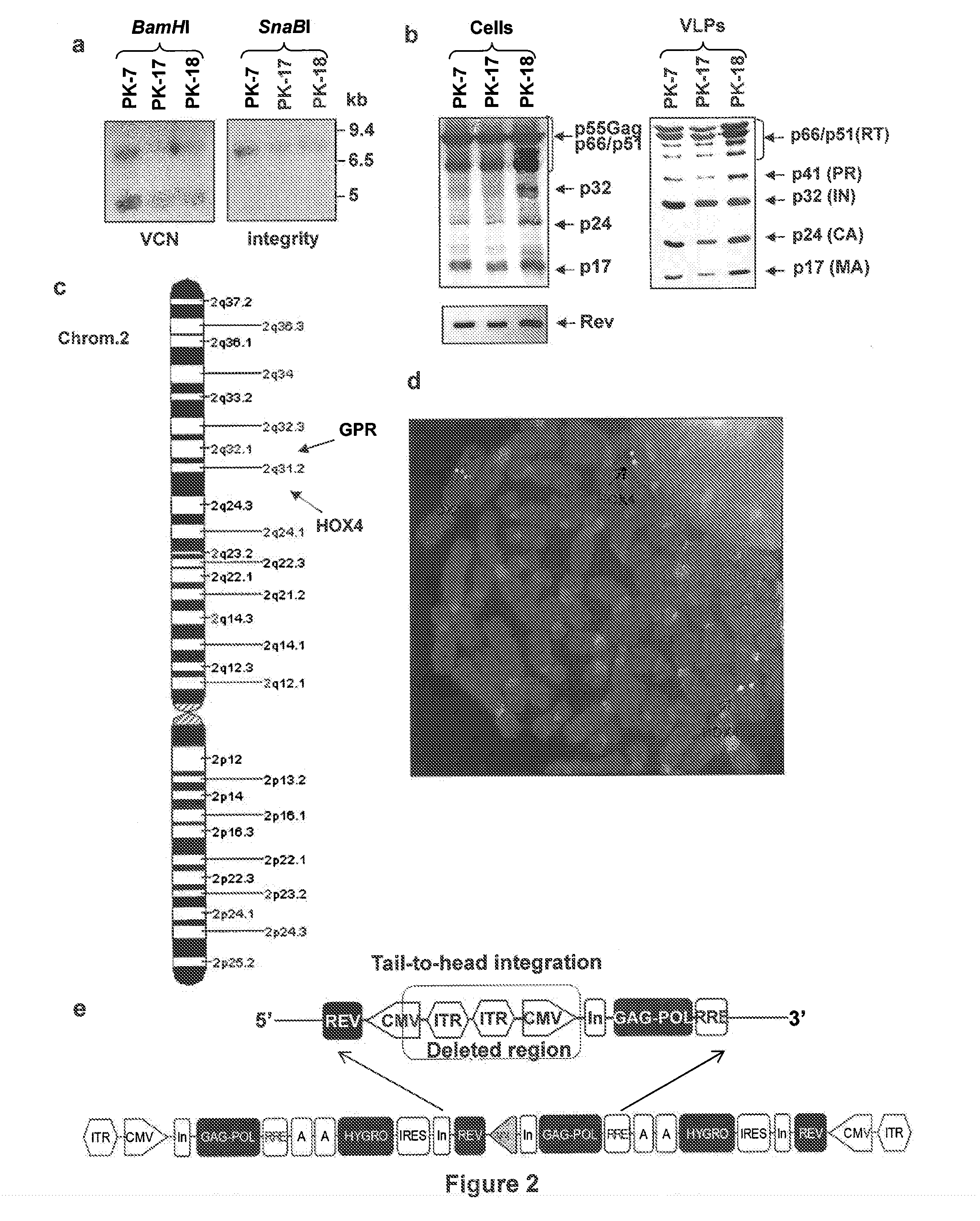Semi-Stable Production of Lentiviral Vectors
a technology of lentiviral vectors and packaging cells, applied in the field of semi-stable production of lentiviral vectors, can solve the problems of difficult standardization and scaling up, high cost of technology, and inability to achieve global application, and achieve the effect of facilitating genome integration of baculo-aav packaging vectors, stable integration of structural and regulatory, and stably and effectively engineering host cells
- Summary
- Abstract
- Description
- Claims
- Application Information
AI Technical Summary
Benefits of technology
Problems solved by technology
Method used
Image
Examples
example i
General Methods
Plasmids
[0059]Wild-type HIV-1 gag, pol and rev genes were excised by MluI / NarI and MluI / NotI digestions from the pCG719-pKLgagpol (hereafter named CMV-GPR for simplicity) (FIG. 1a, scheme 9) and pCG720-pKrev (CMV-Rev) (FIG. 1a, scheme 5) plasmids, respectively25. The viral genes were inserted into the Gateway® pENTR™4 shuttle vector (Invitrogen, Co., Carlsbad, Calif.) in two distinct expression cassettes tail-to-tail oriented, each cassette driven by a CMV IE promoter and carrying a polyA sequence. The first cassette expresses the gag and pol genes whereas the second one the rev gene and the selection marker hygromycin resistance (hygro) gene; hygro was cloned downstream an IRES to allow bi-cistronic translation. The two expression units were introduced into the XbaI site of the recombinant pSUB201 plasmid carrying an infectious AAV genome17. The resulting 5′ITR-CMV-gagpol-polyA-polyA-hygro-IRES-rev-CMV-ITR3′ cassette was then excised and inserted into the Gateway®pEN...
example ii
Generation of the First Intermediate PK-7 Clone
[0071]To obtain the RD-Mol Pack packaging cell line for the continuous production of either 2nd- or 3rd-generation LV, several HEK293T-derived intermediate clones were obtained. The first one was named PK-7 and was obtained by stable integration of HIV-1 gag, pol, and rev genes by means of the recombinant hybrid baculo-AAV vector (rhBaculo-AAV-GPR) (FIG. 1a, scheme 1). This delivery system exploits the integrase activity of AAV-rep78 protein, provided transiently, to excise and integrate the AAV ITR-flanked integration cassettes into human chromosomes (FIG. 1b). The rh-baculo-AAV vector was generated by homologous recombination between the BaculoDirect Linear DNA and the Gateway® pENTR™4 entry plasmid containing the ITR-flanked GPR cassettes (FIG. 1a, scheme 1). After 3 cycles (p3) of recombinant baculovirus amplification in Sf9 insect cells, the titer and the potential recombination events of the hybrid baculo-AAV DNA were checked by p...
example iii
Use of PK-7 Clone for Semi-Stable LV Production
[0076]To better establish whether the semi-stable LV production from PK-7 clone was overall comparable to that of transient LV production from HEK293T cells, both cell types were transfected with the same amount of the necessary plasmids and measured the percentage of transfection and the potency of their respective LVs on different target cells (Table 3). In this condition, the mean of the percentage of transfection of 11 experiments with HEK293T cells was 90.54±3.6 SEM and that of 12 experiments with PK-7 cells was 91±5.3SEM, indicating that PK-7 cells maintain their high-level transfection capability. Then, the LV titer was calculated in SupT1 cells, as our standard reference cell type, cord blood derived CD34+HSC, and anti-CD3 / IL-2 activated cord blood mononucleated cells (indicated as T lymph. in Table 3) (Table 3).
TABLE 3Potency of VSV-G pseudotyped 3rd and 2nd generation LV producedfrom PK-7 clone calculated on different target c...
PUM
| Property | Measurement | Unit |
|---|---|---|
| Temperature | aaaaa | aaaaa |
| Mass | aaaaa | aaaaa |
| Mass | aaaaa | aaaaa |
Abstract
Description
Claims
Application Information
 Login to View More
Login to View More - R&D
- Intellectual Property
- Life Sciences
- Materials
- Tech Scout
- Unparalleled Data Quality
- Higher Quality Content
- 60% Fewer Hallucinations
Browse by: Latest US Patents, China's latest patents, Technical Efficacy Thesaurus, Application Domain, Technology Topic, Popular Technical Reports.
© 2025 PatSnap. All rights reserved.Legal|Privacy policy|Modern Slavery Act Transparency Statement|Sitemap|About US| Contact US: help@patsnap.com



